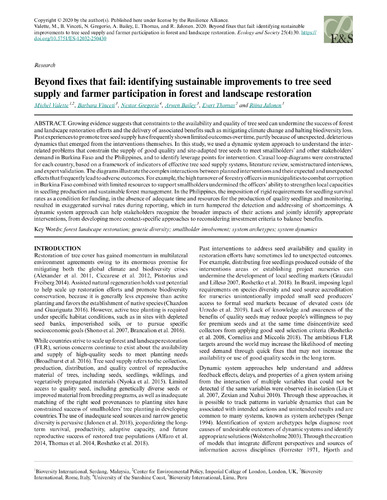Beyond fixes that fail: identifying sustainable improvements to tree seed supply and farmer participation in forest and landscape restoration
Growing evidence suggests that constraints to the availability and quality of tree seed can undermine the success of forest
and landscape restoration efforts and the delivery of associated benefits such as mitigating climate change and halting biodiversity loss.
Past experiences to promote tree seed supply have frequently shown limited outcomes over time, partly because of unexpected, deleterious
dynamics that emerged from the interventions themselves. In this study, we used a dynamic system approach to understand the interrelated problems that constrain the supply of good quality and site-adapted tree seeds to meet smallholders’ and other stakeholders’
demand in Burkina Faso and the Philippines, and to identify leverage points for intervention. Causal loop diagrams were constructed
for each country, based on a framework of indicators of effective tree seed supply systems, literature review, semistructured interviews,
and expert validation. The diagrams illustrate the complex interactions between planned interventions and their expected and unexpected
effects that frequently lead to adverse outcomes. For example, the high turnover of forestry officers in municipalities to combat corruption
in Burkina Faso combined with limited resources to support smallholders undermined the officers’ ability to strengthen local capacities
in seedling production and sustainable forest management. In the Philippines, the imposition of rigid requirements for seedling survival
rates as a condition for funding, in the absence of adequate time and resources for the production of quality seedlings and monitoring,
resulted in exaggerated survival rates during reporting, which in turn hampered the detection and addressing of shortcomings. A
dynamic system approach can help stakeholders recognize the broader impacts of their actions and jointly identify appropriate
interventions, from developing more context-specific approaches to reconsidering investment criteria to balance benefits.

